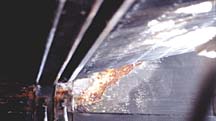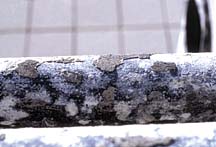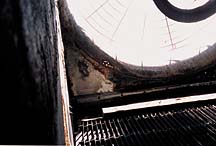
That’s when questions from the audience indicated that the entire session could have been on white rust and nothing else.
White rust occurs on galvanized carbon steel that comes in contact with soft water (less than 30 ppm total hardness, greater than 8.2 pH). “Soft water can be very aggressive,” Silverstein said. “It needs some hardness.” It can cause brand-new, untreated condensers and cooling towers to fail in a very short time.
White rust is described as a waxy, white coating that you can wipe away. In an earlier RETA conference, it was described as looking like “white tips of a feather.” Progressive failure can lead to “tubercles” (nodules) that one audience member said resembled barnacles.
Areas underneath the white rust turn black and then red. “When it turns to red, you’re in trouble,” said an audience member.
KNOW YOUR WATER
To help prevent premature failures of newly installed evaporators, it behooves a contractor to find out about local water conditions, which can determine whether or not passivation is needed. Soft water and high phosphates can cause the zinc galvanization to “sacrifice” itself.White rust is the result. It can quickly strip away a zinc coating completely.

According to chemical manufacturer ProChemTech, Brockway, PA, white rust “occurs anytime zinc, or galvanized steel, is exposed to water that has a pH value above 8.2. The rate of corrosion, however, is governed by the alkalinity of the water and presence of any accelerating agents, such as phosphates and phosphonates. Higher alkalinity, and the presence of accelerating agents, substantially increase the corrosion rate.”
As expected, experts assert it is easier to prevent white rust than it is to get rid of it. To prevent it in a new system, contractors need to work with a water treatment firm to passivate the system. The company also should be able to provide water testing. Passivation is chemical water pretreatment of galvanized steel that helps form a protective coating to prevent corrosion initially.
“Lower the pH in order to passivate,” said Silverstein, on new installations and every six months thereafter. Water quality should be examined with every piece of new equipment.
“Some water treatment people want to keep the condenser off [for passivation] for as long as 30 days,” Silverstein said. He said that he thought it shouldn’t take quite that long, “but maybe for days or up to a week.”
Almost all installing contractors exclude water treatment, he commented. Contractors should be able to give a list of water treatment firms to the owner.
“If you’re not going to maintain it, kiss it goodbye,” Silverstein said. “Watch your pH.”

WHITE RUST INHIBITOR
A few zinc corrosion inhibitors on the market can be used in conjunction with passivation. One such is ZincGard™ white rust control from ProChemTech.Tim Keister, chief chemist for the company, said the product “goes right into the cooling tower chemistry.” It also is sold to other chemical companies for formulation into their products.
“It could be used as pretreatment” of galvanized steel, “but it’s not permanent,” he said. “It’s almost identical to the way you use azoles,” a wood-preservative treatment.
The company describes its product as “a specific group of organic chemical compounds found to directly inhibit corrosion of zinc (galvanized steel) in contact with alkaline waters.” Before using ZincGard, Keister recommends passivating with phosphate chemistry.

“We softened some water; when you do that, white rust becomes a horrible problem,” Keister said. He spoke of some cooling applications where the zinc was stripped after only three months.
Changes to zinc galvanizing methods have also been pointed out as contributing to the problem.
Some companies are using “white oil” pretreatment and other methods to protect galvanized steel from white rust. However, “Soluble oil will come off,” Keister pointed out. “It needs to be reapplied and can result in biofouling.”
If some contractors are wondering whether acidic cleaning products (such as Lime-Away) can take care of existing white rust, Keister had this advice: “Lime-Away, and other similar products, is a simple acid which will remove the white rust deposits from the galvanized metal. Removal of the deposit will neither accelerate nor retard ongoing white rust corrosion.
“If a good inhibitor program is started right after the acid cleaning, the cleaning would be of benefit. People using acids for cleaning should be aware that if they use a little too much acid, all the galvanize will be taken off the steel — bad thing!”
Publication date: 11/18/2002



